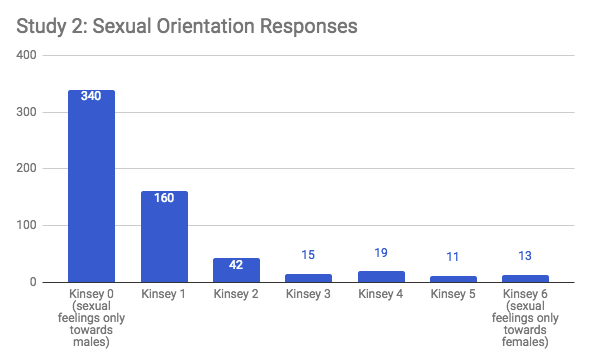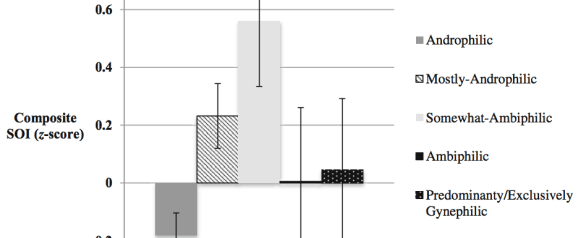In an article published this month in Evolutionary Psychological Science, researchers found that moderately bisexual women reported higher levels of psychopathy, narcissism and Machiavellianism (aka. manipulative, self-interested behavior). As a group, bisexual women also reported less-restricted attitudes, desires and willingness to engage in to uncommitted sexual behavior. If this sounds familiar, that’s because these findings essentially uphold the insidious, well-worn trope of the Depraved Bisexual! Super cool, I know! Let’s take a closer look.
In the first of the two studies covered in the article, researchers deployed Jonason and Webster’s Dirty Dozen scale, asking participants to rate how much they agreed with 12 self-referent statements, including “I tend to be callous or insensitive,” and “I have used deceit or lied to get my way.” The scale measures personality traits known together as the “Dark Triad” (Machiavellianism, psychopathy, and narcissism), and in general, is studied in applied psychology through the lens of “these socially nonconformist traits are undesirable” and “let’s figure out why you’re like this.” Historically, studies have shown higher prevalence of DT traits among men, who as a group are positively correlated with masculinity. Given that lesbian and bisexual women tend to evaluate themselves as being more masculine than straight women, this study asked, is there also a positive correlation with DT traits?
To answer this question:
A total of 446 female students at a Midwestern Canadian University completed a questionnaire for course credit in their introductory psychology course. Three participants were excluded due to missing data, leaving 443 for analysis. The average age of the participants was 20.81 years (SDage = 5.03; Range = 16–57). … There were 308 self-identified exclusively heterosexual individuals, 108 mostly heterosexual, 20 as bisexual, 3 mostly homosexual, and 0 exclusively homosexual participants. Four participants declined to answer.
As lead author Scott W. Semenyna explained to Psypost, “This study was conducted on an extremely WEIRD sample (i.e., Western, Educated, Industrialized, Rich, and Democratic). It’s unclear whether these differences apply only to university students, if similar differences may exist in the general population, or what possible cross-cultural variation exists in these patterns.” Yes to that, and also: there were no lesbians. This doesn’t mean the findings are “wrong,” necessarily, but it does seem quite a significant gap in coverage for a study on female sexuality; be careful interpreting the results.
In the second study covered in the research article, a recruitment script specifically invited non-heterosexual women to participate, resulting in 13 Kinsey 6 lesbians, 340 Kinsey 0 straight women, and 247 in-between responses. Again, the WEIRD biases apply, with an average respondent age of 20.40.

This time, DT traits were assessed using Jones and Paulhus’s Short Dark Triad scale, with 27 self-referent statements (9 for each DT trait) including “You should wait for the right time to get back at people,” and “I insist on getting the respect I deserve.” Using this method, study 2 did not replicate the findings of study 1 regarding sexual orientation differences in Machiavellianism and overall Dark Triad traits.
Also in study 2, sociosexuality was assessed using the Sociosexual Orientation Inventory (SOI), which assesses individual’s behavior and attitudes pertaining to uncommitted sexual relationships. The SOI contains open response questions such as “with how many different partners have you had sex (sexual intercourse) within the past year?” as well as scaled items to which participants indicate the extent to which they disagree (1) or agree (9) with statements such as “sex without love is okay.”
Researchers took a look at the relationship between different groups on the Kinsey scale:
Most strikingly, study 2 found that somewhat ambiphilic (Kinsey 2) women have higher sociosexuality [specifically, more favorable attitudes towards casual sex, and a higher sex drive] than most other groups, with moderate to large effect sizes. The relationship between women’s sexual orientation and less restricted sociosexuality was found to be curvilinear, replicating previous studies showing bisexual women to be higher in sociosexuality than heterosexual or homosexual women (Lippa 2006, 2007; Schmitt 2007), but adding granularity regarding sexual orientation groupings. More specifically, mostly androphilic (Kinsey 1) and somewhat ambiphilic (Kinsey 2) women exhibited higher sociosexuality compared to ambiphilic women (Kinsey 3–4), although all of these groups have been characterized as “bisexual” in the literature.

Speaking about the findings, Semenyna noted, “Primarily such evidence is consistent with the hypothesis that female bisexuality and female homosexuality are the result of different developmental processes. If female bisexuality and homosexuality were simply the result of the same underlying developmental processes, one would expect that any differences between heterosexual and bisexual women in personality or interest in casual sex would be even larger when comparing heterosexual and lesbian women.”
To me, the interesting takeaway here is that “bisexual” may be too broad a term to be useful in some research settings, as there are distinct subgroup behaviors (perhaps due to different bio-developmental roots). I would love to see more research done in this vein, in particular to address the biased study population. Interesting as 20-year-old students studying psych are, it seems obvious that their answers are going to differ from the general population. (Pretty sure we didn’t have this many bisexual Slytherins at A-Camp, for example. Or maybe I was just hanging out in the wrong cabin.)

